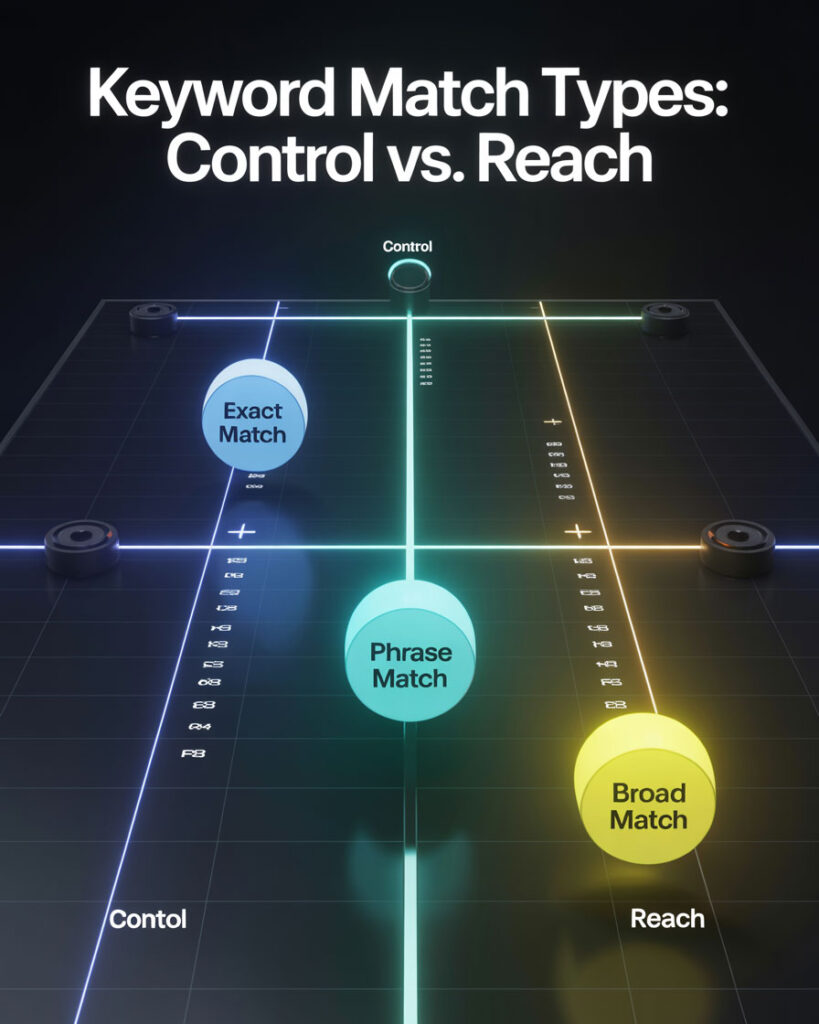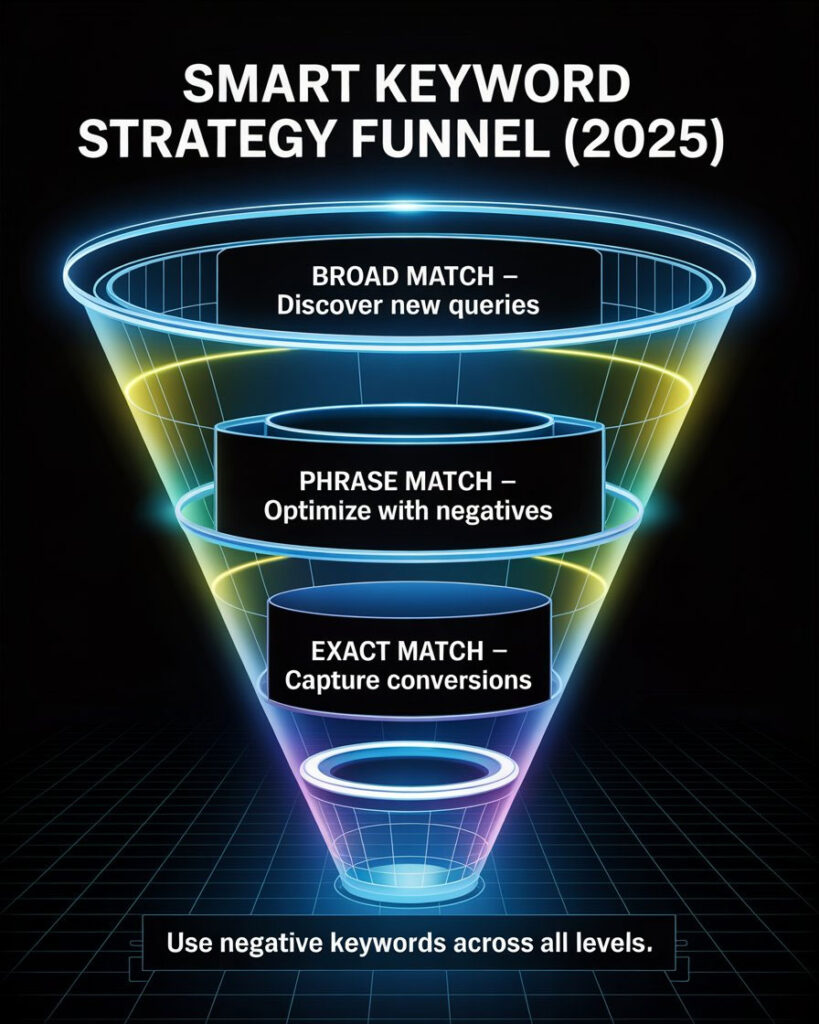Choosing the right keyword match types is one of the most underrated levers in Google Ads performance. If your ads aren’t showing for the right queries — or are triggering the wrong clicks — the problem usually starts here.
In this article, we’ll break down the current keyword match types, show how they work in real search scenarios, and explain when (and why) to use each for better results.
What Are Keyword Match Types?
Keyword match types control how closely a user’s search query must align with your selected keyword in order for your ad to appear. Each type gives you a different level of control over reach, targeting precision, and cost.
Understanding match types is fundamental for:
- Getting qualified traffic
- Reducing irrelevant clicks
- Lowering cost-per-acquisition (CPA)
- Improving ad relevance and Quality Score
As of 2025, Google Ads supports three main keyword match types:
- Exact Match
- Phrase Match
- Broad Match
Let’s explore how each one works in practice.

1. Exact Match: Hyper-Targeted, High-Intent Traffic
Format: [keyword]
Definition: Ads appear only for searches that match your keyword exactly or are close variants (e.g., plurals, misspellings, reordered words with the same meaning).
Example:
- Your keyword: [wedding photographer nyc]
- May trigger: wedding photographer nyc, nyc wedding photographer
- Won’t trigger: best photographers for weddings in nyc
Use When:
- You want to attract users ready to convert
- You have a limited budget and need maximum efficiency
- You’re targeting branded, niche, or high-intent terms
Pros:
- Highest relevance and intent
- Minimal wasted ad spend
- Easier to control ROI
Cons:
- Limited reach
- Requires comprehensive keyword lists
2. Phrase Match: Balanced Control and Flexibility
Format: “keyword”
Definition: Ads trigger for queries that include the meaning of your keyword phrase — possibly with additional words before or after. Order and context still matter.
Example:
- Your keyword: “family lawyer toronto”
- May trigger: affordable family lawyer toronto, hire family lawyer toronto today
- Won’t trigger: toronto family legal advice, lawyer for custody issues
Use When:
- You want reach + relevance
- You’re targeting mid-funnel users (consideration phase)
- You want tighter control than broad match without sacrificing too much volume
Pros:
- Great balance of traffic and intent
- Fewer irrelevant clicks than broad match
- Useful for long-tail queries
Cons:
- Still possible to get irrelevant traffic
- Requires ongoing use of negative keywords
3. Broad Match: Maximum Reach, Machine-Learning Driven
Format: keyword
Definition: Google’s AI interprets user intent and matches your ad to relevant queries, even if they don’t contain the exact keyword. This includes synonyms, related concepts, and behavior-based predictions.
Example:
- Your keyword: women’s running shoes
- May trigger: athletic footwear for women, trail sneakers, best shoes for marathon training
Use When:
- You use smart bidding (Maximize Conversions, Target CPA)
- You want to discover new high-intent queries
- You have robust tracking and budget for experimentation
Pros:
- Maximum impression share
- Opportunity to scale quickly
- Helps find hidden-performing queries
Cons:
- Requires trust in Google’s automation
- Higher potential for irrelevant clicks
- Demands regular analysis of the Search Terms Report
Why Negative Keywords Still Matter

No matter what match type you choose, negative keywords are your insurance policy. They block your ads from appearing on irrelevant or low-converting searches.
Examples:
- -free
- -job
- -DIY
- -cheap
Build and refine your negative keyword lists continuously. It’s one of the fastest ways to boost CTR and reduce wasted spend.
Match Type Strategy Tips for 2025
- Exact match works best for bottom-of-funnel keywords (high intent, purchase-ready)
- Phrase match is your go-to for mid-funnel discovery with some flexibility
- Broad match is best paired with automated bidding and smart goals
- Use negative keywords with all match types — especially phrase and broad
- Check your Search Terms Report weekly (or daily in high-spend accounts)
- Group match types by ad group when testing: don’t mix exact and broad in one group
Figure: Visual comparison of Google Ads keyword match types — when to use exact, phrase, and broad match.
Final Thoughts: Mastering Match Types for ROI
Keyword match types shape the entire performance profile of your campaign. They influence:
- Who sees your ad
- Whether they click
- Whether they convert
- And how much it costs you to acquire a customer
Even small changes in match type strategy can dramatically improve (or tank) your results.
If you’re still guessing which match type to use, or relying too heavily on broad match without proper tracking — it’s time to stop gambling and start optimizing.
Work With 3MY: Your Google Ads Performance Partner
At 3MY, we specialize in ROI-focused PPC strategy — with keyword research, match type planning, negative keyword structures, and conversion tracking all built in from day one.
Whether you’re just launching your first Google Ads campaign or scaling a seven-figure lead-gen funnel, we can help structure it for better efficiency, lower CPC, and higher-quality leads.
Every campaign includes:
- Custom keyword strategy (exact, phrase, and broad mix)
- Negative keyword curation and monitoring
- Smart bidding setup and conversion tracking
- Weekly reporting and search term review
- Ongoing campaign refinements — not just a one-time setup
Book a Free Strategy Session
Let us help you turn paid traffic into predictable pipeline — keyword by keyword, match by match.










